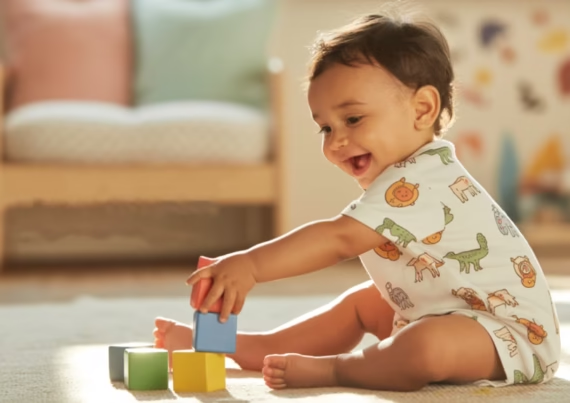Why Personalization is the Key to Success for Baby Clothing Manufacturers
Introduction: How Personalized Customization is Changing the Game for Baby Clothing Manufacturers
The baby clothing market is experiencing a significant shift as parents increasingly seek personalized and unique products for their little ones. Gone are the days when off-the-shelf designs dominated the marketplace. Today, parents desire clothing that reflects their child’s personality, celebrations, and milestones, driving a surge in demand for personalized baby clothing. Manufacturers have recognized this growing trend and are now striving to meet this demand, not only by offering customizable designs but by integrating personalization deeply into their production models.
Personalized customization in baby clothing is becoming more than just a trend; it is reshaping the entire production landscape. For B2B clients, which include retailers, wholesalers, and online marketplaces, the ability to offer personalized products to their customers is proving to be a competitive advantage. They are looking for manufacturers who can provide high-quality, unique, and personalized baby clothing options that can cater to ever-evolving consumer preferences. By meeting this demand, manufacturers can build strong, long-term relationships with their clients while driving sales and increasing their market share.
This article explores how personalized customization can be a game-changer for baby clothing manufacturers. It delves into how adopting flexible production methods, leveraging technology, and maintaining supply chain efficiency can create value for B2B clients, thus enhancing a manufacturer’s market competitiveness.
1.Personalized Customization: How Manufacturers Meet Consumer Demands from the Production Side
Consumer Trends Driving Production Innovation
Today’s parents are no longer content with mass-produced baby clothing that is identical to what everyone else is purchasing. Instead, they are looking for personalized items that allow them to express their child’s individuality. Whether it’s a special embroidered onesie with a child’s name, a unique pattern, or even a specific color, parents are seeking clothing that feels personal and meaningful. As a result, there has been a noticeable shift in consumer behavior, with more and more individuals willing to pay a premium for these customized options.
This growing demand for personalized baby clothing is pushing manufacturers to innovate and adapt their production processes. To meet this demand effectively, manufacturers are not only incorporating customization options but also working towards creating a more flexible and efficient system. For instance, more baby clothing lines are introducing options like monogramming, custom sizing, and design alterations, allowing parents to buy products that reflect their unique preferences.
Innovation from the Production Side
The shift toward personalization presents both challenges and opportunities for manufacturers. Traditionally, clothing manufacturers operated on a mass-production model, churning out large quantities of the same item to meet widespread demand. However, with increasing interest in customization, manufacturers are shifting to more adaptable production methods. Today, many manufacturers are embracing made-to-order models that allow them to produce personalized items in smaller quantities without sacrificing efficiency or quality.
Flexible production lines that allow manufacturers to tailor clothing designs to each order are now a key part of the manufacturing process. By integrating technology like digital printers, automated cutting, and sewing machines, manufacturers can offer a wide variety of customization options without significantly increasing production costs or timelines. These innovations allow manufacturers to remain competitive in a fast-paced market while offering consumers more variety and individuality.
Technological Support and Production Efficiency
The rise of digital printing, laser engraving, and automated stitching technologies has played a critical role in streamlining the customization process for baby clothing manufacturers. These technologies enable manufacturers to produce customized garments quickly and accurately, without relying on traditional, slower, and more costly techniques. For example, digital printing allows manufacturers to apply intricate designs and patterns directly onto fabrics, making customization faster and more cost-effective.
Laser engraving technology allows for highly detailed customizations, such as adding names or unique logos, with precision. Automated stitching and cutting machines ensure that the finished products maintain a high level of quality while being produced at scale. The ability to combine personalized customization with efficient mass production has become a powerful tool for manufacturers to meet both consumer and B2B demands.

With 17 years of experience, petelulu provides a full range of
manufacturing services from design to delivery.
Start from scratch , Create your own brand.
17+
serving top 10 American brands
15+
serving top 10 Australian brands
12+
serving top 10 European brands
Contact us to get the quote.👇
2.How to Improve Supply Chain Efficiency and Reduce Costs Through Personalized Customization
Flexible Production Models
One of the most significant advantages of personalized customization is its ability to reduce inventory buildup. In traditional production models, manufacturers would often overproduce items to account for uncertain demand, leading to excess stock that had to be discounted or even discarded. With made-to-order and personalized customization models, manufacturers can significantly reduce the risk of overproduction.
The made-to-order approach allows manufacturers to produce clothing based on actual consumer demand, eliminating the need to forecast massive quantities of inventory. This flexibility means that manufacturers can focus on producing a smaller, more customized set of products while maintaining operational efficiency. The ability to meet specific orders without overproducing not only reduces waste but also cuts down on storage and inventory costs.
Precise Demand Forecasting
Efficient demand forecasting plays a crucial role in making personalized customization more cost-effective for manufacturers. By using data analysis and artificial intelligence tools, manufacturers can predict which designs, colors, and styles will be in high demand. This data-driven approach allows manufacturers to adjust their production schedules and inventory levels to ensure they can meet personalized orders promptly while maintaining cost control.
For instance, if a particular design becomes popular due to a viral trend or seasonality, manufacturers can adjust their output accordingly, focusing on producing more of that specific design. This helps avoid both overstocking and underproduction, which would negatively impact profits and delivery timelines.
Cost Control and Value-added Services
While personalized customization may initially seem more expensive than mass production, manufacturers can still keep costs under control by offering value-added services. These services, such as offering low-volume orders, quick turnarounds, and special packaging, attract B2B clients who want to differentiate their offerings in the market. By focusing on customer-centric services, manufacturers can make customization more accessible and appealing to retailers and wholesalers.
Furthermore, by utilizing lean manufacturing principles and optimizing their production methods, manufacturers can reduce overhead costs associated with personalized customization. This efficiency, coupled with value-added services, enhances their appeal to B2B clients, enabling them to establish profitable and lasting partnerships.
3.How to Offer Flexible Personalized Customization Options for B2B Clients
Diverse Customization Options for Different B2B Needs
For baby clothing manufacturers to stand out in a competitive market, they must be able to offer a wide range of personalization options that cater to diverse client needs. From embroidered names and custom designs to tailored sizes and fabrics, there are numerous ways to meet the unique requirements of B2B clients.
B2B clients, particularly retailers, will often require several levels of customization. For example, they may need to offer a mix of off-the-shelf items along with personalized products that cater to special occasions like birthdays or holidays. In addition to basic personalization like name embroidery, other options could include personalized graphics, unique patterns, or even custom packaging for special collections. Offering these options allows manufacturers to provide flexible solutions that can fit the varying needs of different B2B clients.
Personalized Customization and Order Volume
One of the challenges in offering personalized customization for B2B clients is ensuring that manufacturers can balance personalized orders with bulk production. Large retailers may want to purchase thousands of standard-sized baby clothes for mass retailing, but they also want to offer their customers the option to personalize certain items.
Manufacturers can meet this demand by offering tiered levels of customization. For instance, they could offer standard products for bulk orders, while allowing customers to select personalized elements, such as custom prints or monogramming, for a smaller subset of their order. This way, manufacturers maintain their ability to meet bulk order requirements while still providing the flexibility that B2B clients want.
To efficiently manage this, manufacturers must invest in production systems that can handle both large-scale production runs and custom orders simultaneously. This could include automated customization lines or modular production systems that allow quick switches between bulk and personalized orders.
Ensuring Profitability and Efficiency
While offering personalized options is essential for attracting B2B clients, it is equally important to ensure that manufacturers remain profitable while fulfilling smaller, customized orders. Efficiency in production becomes even more critical in this context. By using automated systems for custom orders, streamlining the production process, and utilizing real-time data to optimize order fulfillment, manufacturers can ensure that they remain cost-effective despite the added complexity of offering personalized products.
Another key to profitability is clear communication with B2B clients about the pricing structure for personalized products. Customization options often come at a higher price point due to the added labor and materials. However, by offering volume discounts for larger orders or discounts on customized designs for repeat customers, manufacturers can strike a balance between personalization and profitability, ensuring both customer satisfaction and healthy margins.
4.Conclusion: Personalized Customization as the Core Driver of Future Success for Manufacturers
Personalized customization has emerged as a central driver of success for baby clothing manufacturers, helping them meet the growing consumer demand for unique, emotionally resonant products. By incorporating flexibility into their production lines, adopting advanced technologies, and fine-tuning their supply chains, manufacturers can cater to both the specific desires of parents and the broader needs of B2B clients.
The growing emphasis on personalized clothing for babies not only adds emotional value but also boosts market differentiation, positioning manufacturers to stay competitive in an increasingly crowded market. B2B clients, from large retailers to niche boutiques, are looking for manufacturers who can offer customized solutions that align with current consumer trends while maintaining production efficiency.
As the baby clothing market continues to evolve, those who embrace personalization and integrate it into their business models will be best positioned for future growth. Personalization, when combined with smart supply chain management and innovative production methods, can create long-term partnerships, increase customer loyalty, and drive profitability.

With 17 years of experience, petelulu provides a full range of
manufacturing services from design to delivery.
Start from scratch , Create your own brand.
17+
serving top 10 American brands
15+
serving top 10 Australian brands
12+
serving top 10 European brands
Contact us to get the quote.👇
5.Call to Action
Baby clothing manufacturers who wish to stay ahead of the curve and thrive in this dynamic market should prioritize personalization as a core component of their production strategy. By offering tailored customization options and innovative solutions, manufacturers can forge strong, mutually beneficial partnerships with B2B clients.
We encourage retailers, wholesalers, and boutique owners to explore personalized customization opportunities with manufacturers that understand the evolving consumer preferences in the baby clothing market. Let’s work together to drive innovation, create unique offerings for customers, and build lasting relationships that foster growth for both manufacturers and their B2B clients.
About the author
Xhiney, founder of Petelulu, brings over 20 years of experience in children’s wear design, production, and international trade. A contributor to Children’s Wear and Junior magazines, Xhiney has spent 17 years working with high-end children’s wear brands in Europe and the U.S., offering expert insights and support.
